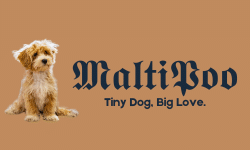Summary
What you feed your Maltipoo plays a huge role in their health, happiness, and energy levels. From high-quality kibble to fresh, homemade meals, the key is choosing real, nutritious ingredients that support their well-being. Every dog is different, so understanding their unique dietary needs and sensitivities will help keep them thriving. With the right diet and a little extra care, your Maltipoo can stay healthy, happy, and full of life for years to come!
Let’s dive in!
If you own a Maltipoo, you already know how special these little dogs are. A mix between the Maltese and the Poodle, they are affectionate, playful, and full of personality. But when it comes to feeding them, many owners struggle to find the right food. Maltipoos have sensitive stomachs, and the wrong diet can lead to digestive issues, allergies, or low energy levels.

I’ve spent years raising Maltipoos, testing different foods, consulting vets, and figuring out what truly works. The right diet can make all the difference in their coat health, digestion, and overall happiness. This guide will walk you through everything you need to know about feeding your Maltipoo, from the best food choices to their unique nutritional needs.
Understand a Maltipoo’s Nutritional Needs
Maltipoos may be small, but their dietary needs are specific. They need a balanced mix of proteins, healthy fats, and carbohydrates to stay active and healthy.
Ideal Macronutrient Balance
After trying multiple diets, I’ve found that the best nutrition for Maltipoos follows this ratio:
- Protein (40-50%) – Essential for muscle strength and immune health. High-quality sources include chicken, turkey, salmon, and lamb. I’ve noticed that salmon-based foods, like Merrick Lil’ Plates Grain-Free Salmon & Sweet Potato, help improve their coat health.
- Healthy Fats (15-20%) – Keep their skin healthy and coat shiny. The best sources are fish oil, flaxseed, and coconut oil. Foods like Wellness CORE RawRev Small Breed include great fat sources.
- Carbohydrates (30-40%) – Provide energy and fiber for digestion. Sweet potatoes, brown rice, and oatmeal work well.
Essential Vitamins and Minerals
A balanced Maltipoo diet should include calcium and phosphorus for strong bones and teeth, along with omega-3 and omega-6 fatty acids to maintain healthy skin and a shiny coat. Glucosamine and chondroitin support joint health, especially in aging dogs, while probiotics and fiber aid digestion and prevent bloating.
Dry Kibble vs. Wet Food vs. Raw Diet: What’s Best?
After years of experience, I’ve learned that a mix of dry and wet food is the best approach.
- Dry Kibble – Keeps teeth clean and is easy to store. Top picks: Wellness CORE RawRev Small Breed, Blue Buffalo Life Protection Small Breed.
- Wet Food – More flavorful and hydrating but can be expensive. Best options: Hill’s Science Diet Small Paws, Nutro Ultra Small Breed.
- Raw Diet – Some owners prefer raw feeding, but it requires careful preparation. I recommend Stella & Chewy’s Freeze-Dried Raw Patties for a safe and convenient raw option.
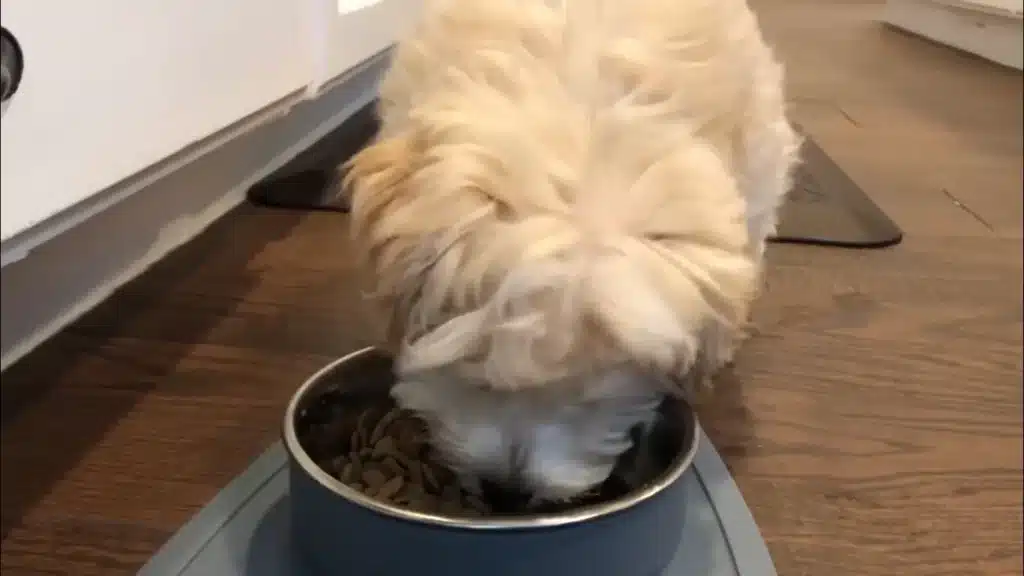
Best Dog Food for Maltipoos (Top Picks)
Choosing the right dog food is overwhelming, but after testing many brands, I’ve found that quality ingredients and a balanced formula are key.
How to Choose the Best Food
- Real Meat as the First Ingredient – Avoid by-products and fillers.
- Grain-Free vs. Whole Grains – Some Maltipoos do well on grains like brown rice, while others need grain-free options.
- No Artificial Preservatives – Avoid food with artificial colors or additives.
- Small Kibble Size – Maltipoos have tiny mouths and need food they can chew easily.
Best Dry Dog Food for Maltipoos
Wellness CORE RawRev Small Breed:
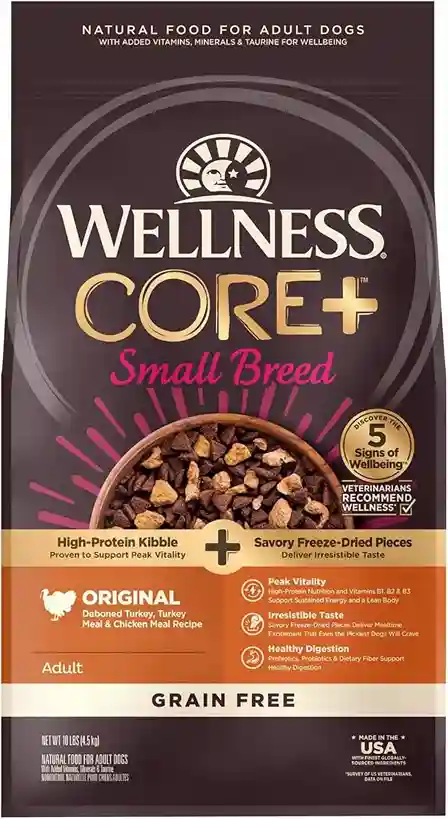
is an excellent choice for Maltipoos, especially those with high energy levels. This grain-free formula is packed with premium animal protein, featuring deboned turkey, chicken meal, and freeze-dried raw bites to provide a balanced mix of kibble and raw nutrition.
The added glucosamine and chondroitin help support joint health, which is essential for small breeds prone to mobility issues. My Maltipoo, Charlie, thrived on this formula, showing improved energy levels and a shinier coat within weeks. If your Maltipoo is active and needs a protein-rich diet, this is one of the best options available. You can check it from here.
Blue Buffalo Life Protection Small Breed:
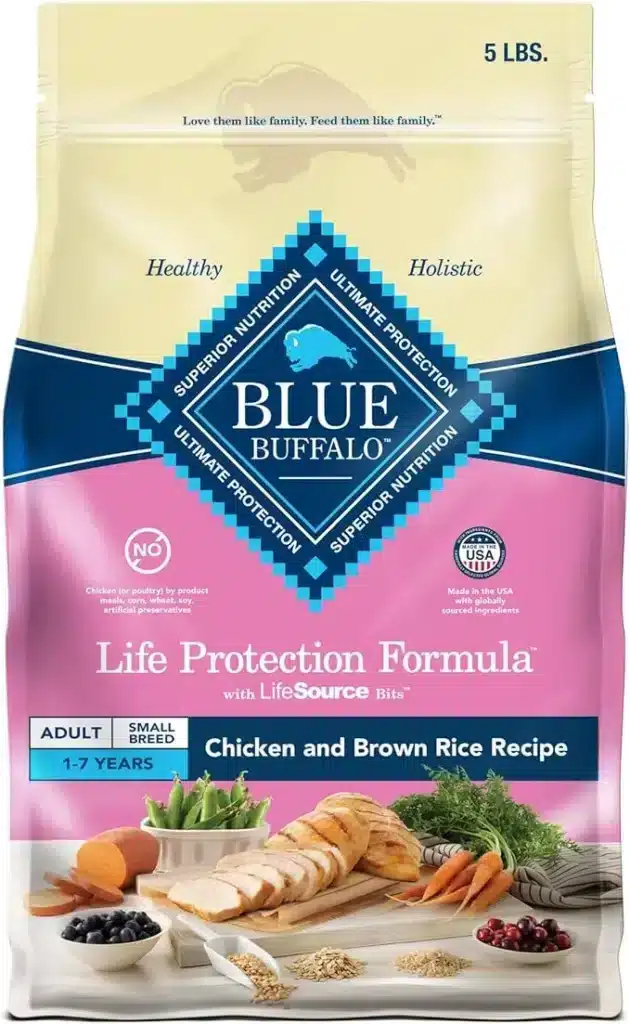
It is a well-balanced dog food designed for everyday nutrition. Unlike some grain-free diets, this one contains wholesome grains like brown rice and oatmeal, which provide steady energy throughout the day. The primary ingredient is real deboned chicken, offering high-quality protein to support muscle maintenance.
It also contains Blue Buffalo’s exclusive LifeSource Bits, which are loaded with antioxidants, vitamins, and minerals to boost immune health. This is a great option for Maltipoos who need a mix of protein, healthy grains, and essential nutrients without artificial additives. You can check it from here.
Royal Canin Small Breed Adult
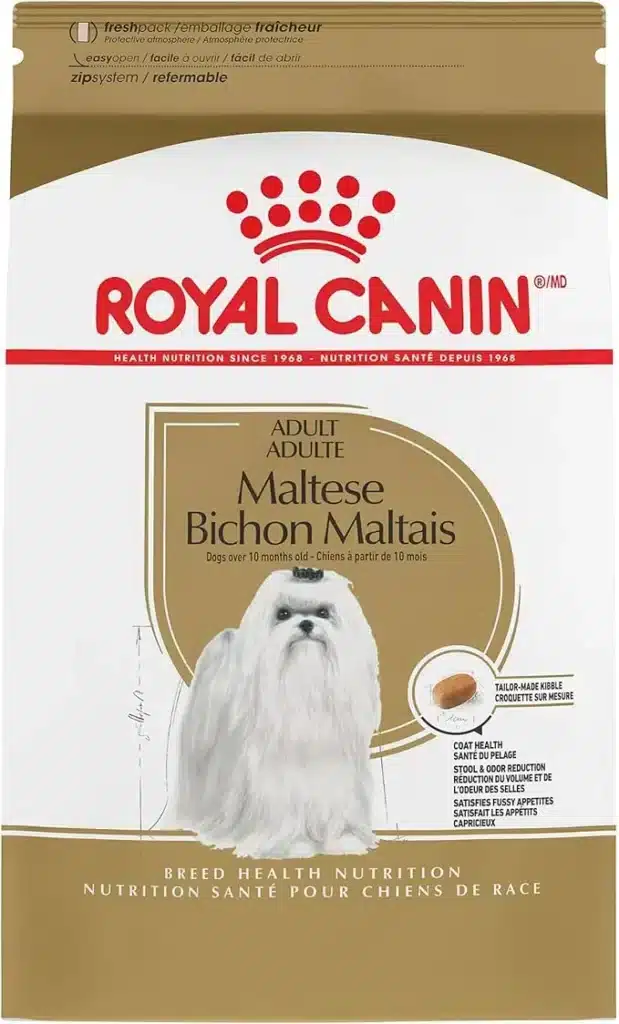
It is a top choice for picky eaters and Maltipoos with sensitive digestion. This kibble is specifically formulated for small breeds, with a unique shape that makes it easier to chew. The formula includes highly digestible proteins and prebiotics, which promote a healthy gut and reduce stomach issues.
Many Maltipoo owners find that Royal Canin helps with food sensitivities, loose stools, and overall digestion. If your Maltipoo struggles with allergies or is a fussy eater, this vet-recommended brand could be the perfect fit. You can check it from here.
You might interested in: Maltipoo Puppies: Costs, Growth & Must-Know Facts!
Best Wet Dog Food for Maltipoos
Hill’s Science Diet Small Paws:
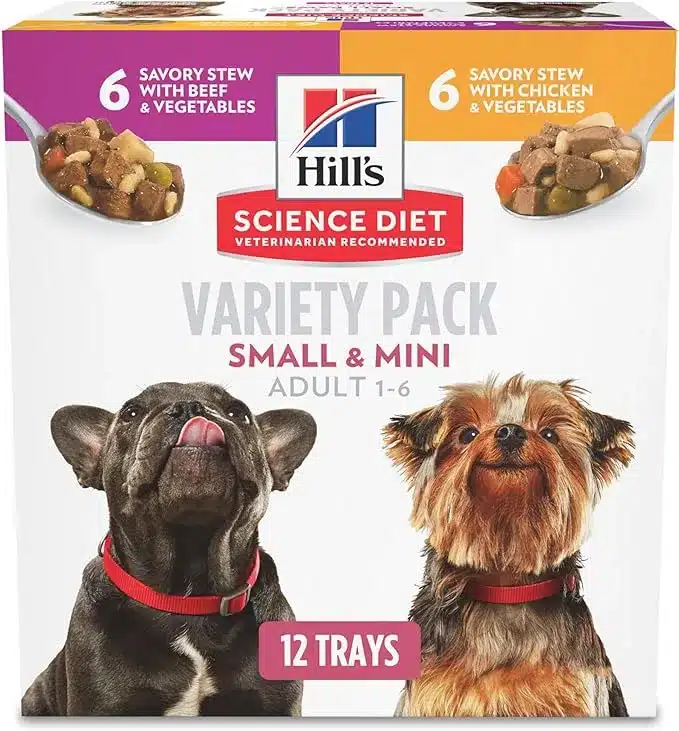
It is a vet-recommended formula designed to support digestion and skin health in small breeds like Maltipoos. It contains highly digestible ingredients, including real chicken and brown rice, along with omega fatty acids and vitamin E to promote a healthy coat.
If your Maltipoo has a sensitive stomach or dry, itchy skin, this food is a great choice. You can check it from here.
Nutro Ultra Grain-Free Small Breed:

It offers a balanced diet with a blend of lean proteins (chicken, lamb, and salmon) and superfoods like coconut, chia seeds, and kale. It’s ideal for Maltipoos that need a nutrient-dense diet for overall health, including strong muscles, a shiny coat, and boosted immunity.You can check it from here.
Merrick Lil’ Plates Small Breed Pâté:
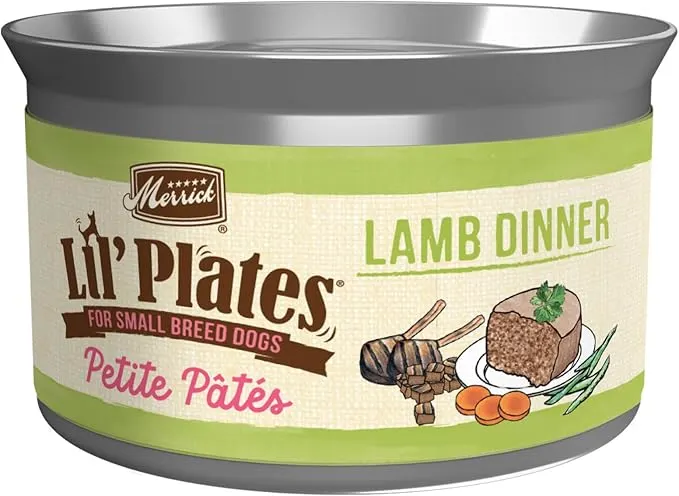
It is a high-protein, grain-free wet food that’s perfect for picky eaters. Made with real deboned meat like beef or chicken, this pâté provides rich flavor and easy digestion.
Making it an excellent option for Maltipoos who prefer soft food or need extra hydration in their diet. You can check it from here.
Best Fresh & Homemade Dog Food Delivery Services
If you want fresh, human-grade food, these are my top choices:
- The Farmer’s Dog – Fresh, vet-designed meals customized for your Maltipoo.
- Ollie – High-quality, minimally processed food tailored to your dog’s needs.
- Nom Nom – Vet-formulated, restaurant-quality dog food delivered to your door.
I personally feed my Maltipoo The Farmer’s Dog, and within weeks, I noticed better digestion and a shinier coat.
Also read: How Long Do Maltipoos Live?
Best Dog Food for Maltipoos with Allergies
What Foods Are Maltipoos Commonly Allergic To?
Food allergies are common in Maltipoos, and certain ingredients can trigger itching, digestive issues, and ear infections. Chicken is one of the most frequent allergens, despite being a common protein source in dog food. If your Maltipoo constantly scratches or has recurring ear infections, a chicken-free diet may be worth considering.
Dairy products can also cause issues. While some dogs can tolerate plain yogurt or cheese in small amounts, many Maltipoos experience digestive upset due to lactose intolerance. Symptoms like bloating, diarrhea, and gas often indicate that dairy isn’t a good choice for them.
Wheat and soy, often used as fillers in lower-quality dog foods, are known to cause allergies in some dogs. If your Maltipoo has chronic itching or digestive problems, switching to a grain-free or limited-ingredient diet can help identify and eliminate the cause.
You may interested: Maltipoo Growth Chart
Symptoms of Food Allergies
If your Maltipoo has an allergy, they may experience itchy skin and constant scratching. Their ears might become red, inflamed, or prone to frequent infections. Digestive issues like vomiting, diarrhea, or bloating can also be signs of food intolerance. Identifying and eliminating the allergen from their diet can help relieve symptoms.
Best Hypoallergenic Dog Food Brands
For Maltipoos with allergies, these foods have worked well:
- Canidae Pure Small Breed – A limited-ingredient diet with high-quality proteins.
- Blue Buffalo Basics Limited Ingredient Diet – Grain-free and free from common allergens.
- Natural Balance L.I.D. Small Breed – Uses simple ingredients to reduce allergic reactions.
Also read about: Maltipoo Bichon Frise Mix
Are Limited Ingredient Diets Good for Allergic Maltipoos?
Yes! Limited ingredient diets (LID) help eliminate triggers while still providing balanced nutrition. If your Maltipoo has food sensitivities, switching to a hypoallergenic formula can reduce itching, digestive problems, and other allergic reactions.
Human Foods and Maltipoos: What’s Safe & What’s Not?
Many dog owners love to share their food with their pets, but not everything we eat is safe for a Maltipoo. While some human foods offer health benefits, others can be toxic and even life-threatening. Understanding what’s safe and what’s not can prevent serious health issues and unnecessary vet visits.
Can Maltipoos Eat Human Food?
Maltipoos can eat certain human foods in moderation, but their diet should primarily consist of well-balanced dog food. While it’s tempting to give them table scraps, some ingredients that seem harmless to us can upset their digestive system or lead to long-term health problems. If you want to include human food in their diet, it’s essential to know which ones are safe and how much they can consume.
What Foods Are Bad for Maltipoos?
Some foods are not only bad for Maltipoos but can also be toxic. Chocolate is one of the most well-known dangers. It contains theobromine, which can cause vomiting, rapid heart rate, seizures, and even death in small dogs. Even a small piece can be harmful, so it’s best to keep all chocolate products out of reach.
Grapes and raisins are equally dangerous, even in tiny amounts. They can cause kidney failure, leading to lethargy, loss of appetite, and increased thirst. Since researchers haven’t determined exactly why grapes are toxic to dogs, it’s safest to avoid them completely.
Onions and garlic, whether raw, cooked, or powdered, can damage a Maltipoo’s red blood cells, leading to anemia. Symptoms include weakness, pale gums, and shortness of breath. While small amounts of garlic are sometimes used in holistic dog diets, it’s generally best to avoid it unless approved by a veterinarian.
Xylitol, a sugar substitute found in sugar-free gum, candies, and some peanut butter brands, is extremely toxic to dogs. Even a tiny amount can cause a dangerous drop in blood sugar, leading to seizures or liver failure. Always check ingredient labels before giving your Maltipoo any human food.
Can Maltipoos Eat Scrambled Eggs?
Yes, scrambled eggs can be a healthy and nutritious treat for a Maltipoo. Eggs are packed with protein, essential amino acids, and healthy fats that support coat health and muscle development. They are also easily digestible, making them a great option for dogs with sensitive stomachs.
However, it’s important to cook the eggs without butter, salt, or seasoning. Plain scrambled or boiled eggs are best. While eggs can be a great addition to their diet, they should be fed in moderation. Too many eggs can lead to excess calorie intake, which may contribute to weight gain.
Can Maltipoos Eat Bananas?
Bananas are safe for Maltipoos and can be a great source of vitamins and fiber. They contain potassium, vitamin C, and vitamin B6, which support heart health and digestion. The natural sugars in bananas provide a quick energy boost, making them a good occasional snack.
Since bananas are high in sugar, they should be given in small amounts. A few small pieces as a treat are fine, but feeding too much can lead to weight gain or digestive upset. Always remove the peel before feeding, as it can be difficult for a dog to digest.
Homemade & Raw Diet Options for Maltipoos
Many dog owners consider homemade or raw diets for their Maltipoos, believing it offers better nutrition and fewer artificial additives. While this can be true, it requires careful planning to ensure balanced nutrition.
Homemade diets allow full control over ingredients, which is great for dogs with allergies or sensitivities. A well-balanced homemade meal should include lean protein like turkey or salmon, healthy fats from fish oil or coconut oil, and carbohydrates such as sweet potatoes or brown rice. Adding fresh vegetables like carrots and spinach provides essential vitamins. However, it’s crucial to avoid harmful foods like onions, garlic, and excessive salt.
Raw feeding is another option, but it comes with risks. While raw diets can provide high-quality protein and natural enzymes, they may also contain harmful bacteria if not handled properly. If considering a raw diet, freeze-dried raw food like Stella & Chewy’s Raw Blend is a safer alternative, as it eliminates bacteria while retaining nutrients.
Consulting a vet before switching to raw food is always recommended.
Feeding Tips & Best Practices for Maltipoo Owners
Feeding your Maltipoo properly goes beyond choosing the right food. Many small breeds, including Maltipoos, can be picky eaters. To prevent fussy eating habits, establish a consistent feeding schedule and avoid excessive treats. Mixing a bit of wet food with kibble can make meals more enticing.
Hydration is just as important as food. Maltipoos need access to fresh water at all times, especially when eating dry kibble. Dehydration can lead to digestive problems and lethargy.
Portion sizes depend on your Maltipoo’s weight and activity level. A typical adult Maltipoo needs around 1/2 to 1 cup of food per day, split into two meals. Overfeeding can lead to obesity, so monitoring their weight and adjusting portions as needed is key.
If your Maltipoo experiences food intolerances, signs like excessive scratching, vomiting, or diarrhea may indicate the need for a diet change. Transitioning to a new food should be done gradually over 7-10 days by mixing small amounts of the new food with the old one to avoid stomach upset.
